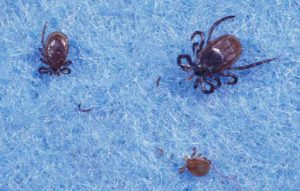Public health officials offer tips to avoid tick bites
May 3, 2021As Lyme Disease Awareness Month begins, the Illinois Department of Public Health (IDPH) is reminding people to take precautions against tick bites to prevent contracting diseases they may carry, like Lyme disease. Other tickborne diseases include Rocky Mountain Spotted Fever, Tularemia, Ehrlichiosis, and Babesiosis.
To avoid tick bites, residents should diligently check themselves, their pets, and help children with a tick check after spending time in areas where ticks live, such as in and near wooded areas, tall grass, and brush. Removing ticks within a 24-hour period reduces the risk of potential disease transmission.
Some tips for healthy outdoor time:
- Learn about tick removal and symptom awareness (IDPH website).
• Walk in the center of trails. Avoid wooded, bushy areas with high grass and leaf litter.
• Wear light-colored clothing to make ticks easier to find. Tuck long pants into socks and boots.
• Apply an EPA-registered insect repellent containing 20 percent DEET, picaridin, IR3535, or Oil of Lemon Eucalyptus according to label directions.
• Conduct full-body tick checks on family members (underarms, ears, belly button, behind knees, between legs, waist, hair and scalp) every two to three hours. Also check any gear or pets taken on outings.
• Put your clothes in the dryer on high for 10 minutes (or one hour for damp clothes) to kill ticks.
• Bathe or shower within two hours after coming indoors.
• If you find a tick on yourself, it is often helpful to keep the tick for species identification. Place the tick in rubbing alcohol or in a sealed bag/container to bring to your healthcare provider or local health department for submission to IDPH. A submission form can be found on the IDPH website.
If you become ill with fever and/or rash after being in an area where ticks may have been, contact your health care provider. Some tick-borne illnesses can be life-threatening. For example, if untreated Rocky Mountain Spotted Fever may cause death as quickly as five days after symptom onset.
For more information on Lyme disease and tick prevention please visit the IDPH website.
For more information on ticks in your area, please visit the IDPH Tick Surveillance Mapping Application: https://arcg.is/15fDSO.








